1. Welcome to Serifos island
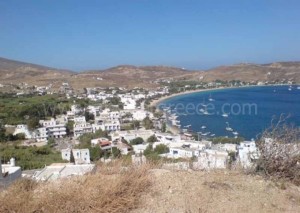
Serifos, is a beautiful, small undiscovered, virgin, unspoiled Greek island located on the west side of the Cyclades, towards the south of Kythnos and to the northwest side of Sifnos. The area of the island is 75.207 km² and the population is about 1,014 at the 2011 census. Serifos is located about 170 km away from Piraeus and the ferry boat takes you just 3 hours to reach Serifos. The island of Serifos is quite popular for its mythology. Surf around these web pages and you will find a complete tourist guide of the beautiful island, containing accommodation on Serifos, the history of Serifos, sightseeing on Serifos, the best beaches on Serifos, activities on Serifos and much more!
REACHING SERIFOS The boat drew alongside Serifos. Its purple looking mountains rise high and vertical. According to mythology, the mountains took this form from Medusa’s frightful look that turned the bad people into stone. Its countless isolated small beaches come into view as we reach the island. If we put the one next to the other we would reach a length of 10 km. gradually, as the ship reaches the port, we see Chora. The optic angle keeps changing as if by magic. Chora disappears and appears again behind the hills looking like a picture postcard. We make a 120 degrees turn at “Kavo Nerou” and there appears the port with Chora on the top, near the light blue sky. The ship lays up at Pounti.
2. Activities on Serifos
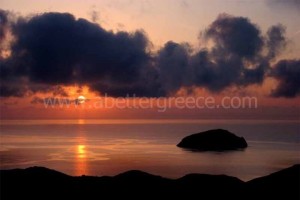
Scuba diving and water sports on Serifos: For the lovers of water sports, scuba diving and trips, there is a Scuba Divers Center on Serifos. The company is well known for its experienced staff and modern equipment from branded factories. You can enjoy the bottom of the sea on Serifos with the aid of a diving apparatus, a mask and a snorkel or just swimming. There are programs that apply to beginners and experts, with spectacular diving destinations or simply snorkeling.
Explore and discover the hidden attractions of Serifos through a variety of activities.
Water sports with the banana, Tube and parachute are also available.
Canoe on Serifos: With or without a guide, you can escape to deserted beaches of your choice. For the more daring, a round-trip of Serifos Island with canoes is also available.
Taxi boat on Serifos: This taxi boat takes you to one of the 72 beautiful beaches on Serifos, just choose the destination of your choice from the map in order to enjoy the sea and the sun.
Rent a boat on Serifos: Rent a boat on Serifos and discover and explore the beaches around the island.
All day boat trip on Serifos: All day boat trips on Serifos are available for swimming, diving, sea sports and programs which are adopted by the divers.
These are just a few of the activities available to the more adventurous. For the vacationer who really needs some rest and recreation, there are some truly beautiful remote beaches with the characteristically pristine, crystal clear waters for which the Greek islands are renowned and where you can laze about soaking up the sun and blissful quiet.
We have tried to give as much information about the island and we shall personally try to make your stay on Serifos remain among the best memories in your life.
3. Best beaches on Serifos
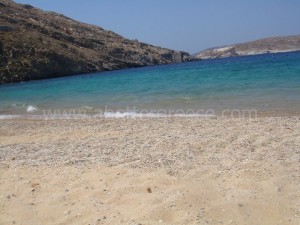
LIVADI BEACH ON SERIFOS: The port is called Livadi and is 2, 5 km long. It offers everything you need to make your stay comfortable, pleasant and memorable. Its name used to be Vathy. The port is extremely safe from north winds and is one of the most popular anchorages of Cyclades. Its sandy beach, Avlomonas, is the biggest of the island (1200 meters). It is quite and has restaurants of various types. At Livadi you will find restaurants with fresh fish or traditional cuisine “on the wave” since most of the restaurants and cafeterias have seats next to the sea. You will also find ouzo shops, dessert shops, every type of accommodation, super markets, keen night fun till the morning and everything else you ask for. Livadi used to be the head of the first mining company and a place of ore shipping with a bridge on the edge of the port, which was destroyed. This is the point where all roads begin for people to see Serifos. Once you get out of the road along the coast, on the left for Chora (in the centre of the port) you will meet a bridge. On its left we head to beaches which lie until Megalo Livadi. On the right of the bridge we go up to Chora. If we go straight ahead to the road for Chora and turn left at the intersection, we will be headed to Megalo Livadi as well, while the road on the right of the intersection leads to Sikamia and goesback to the port from the North-East locations and beaches of the island ending up again in Livadi (port) or returning to Chora by the same road. In addition, we can reach Sikamia by starting off at the end of Avlomonas beach. Note that the road along the coast is a one-way street during the summer months and leads to the intersection of Chora. There is another road above the coastal, also a one-way street, which leads inside the port, exactly on the left once we reach the bridge for Chora while heading for Livadakia.
LIVADAKIA BEACH ON SERIFOS: This beach has the most trees on the whole island, so there is alot of shade for the people that prefer the cool shade to the hot sun. Livadakia beach is a sandy long beach (about 18 kilometers long) located quite close to the port of Serifos, just a ten minute walk from Kavo Pounti. There is a beautiful camp site close to the beach that is considered to be one of the most beautiful camp sites in the Cyclades. New rooms and accommodation are being built all the time and today the buildings already reach the area of Rammos.
KARAVI BEACH ON SERIFOS: Below the area of Rammos, there is a small beach called Karavi, the beach has no shade and is sandy with pebbles. Karavi means ship in the Greek language and the beach has taken its name from the shipwrecks which lie under its ground. In the year 1985, a diver discovered a wreckage at the location where a reef touches the surface according to the currents. At a depth of 12 to 32 meters wine amphorae were found. In the past, tourists used to consider this beach to be a nudist beach where as today nudist bathing is not allowed due to the houses and buildings surrounding the area.
KALO AMBELI BEACH ON SERIFOS: After the area of Rammos, we meet a concrete road. If we turn left we will be heading towards the Kalo ambeli beach (The good vineyard beach). After walking for about ten minutes on a small path we will see this small beach with many dikes and slates. It looks just like a small paradise. As we turn back to the road towards Ganema, on our left we will see the small Glaronisi (The sea gull’s island) while on our right we can also see Oros (only 510 meters).
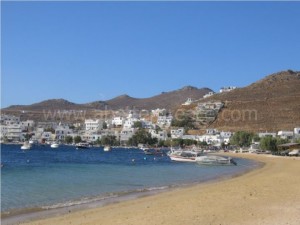
VAGIA BEACH ON SERIFOS: Vagia beach is a large 6 kilometer beach with golden sand but with very little shade. It is a very lonely beach and area. Here you will see the remains of old houses and sheds which used to belong to the workers of the last of the mining period on the island. Wild olive trees, asparagus, vineyards and stubbles decorate the small valley behind the beach.
GANEMA BEACH ON SERIFOS: Another quite long beach with many trees for shade, taverns and restaurants. This beach is about 9 kilometers long. Upon the hill behind the beach you can see the castle of Gria (The old woman;s castle (See sightseeing on Serifos) and at a very close distance lays Koutalas beach.
KOUTALAS BEACH ON SERIFOS: Koutalas beach is about eleven kilometers long, it is connected to Ganema beach by a small dirt road that is about 2,5 kilometers long. The beach is a natural anchorage as it is very safe from the north winds. The beach is long, sandy with thin pebbles; there are trees for shade and a couple of taverns. Tradition says that the wide opening of the bay used to be chained for safety reasons. The bay was known as Porto Kaden (kadena means chain) during the Frankish rule (See the history of Serifos). Upon the surrounding mountains, you can see remnants of rails and the loading ladders for the ships that remain dilapidated. You may also be interested in taking a look at Koutalas Cave (Sightseeing on Serifos).
Around 3,5 kilometers on the road leaving Koutalas beach, we come to a crossroad, if we turn right we will go to the capital city of Chora whereas if we turn left we will reach the historical Megalo Livadi.
MEGALO VILLAGE OR MIA VILLAGE ON SERIFOS: A long, clean beach (around 15 kilometers). In the early years of the 20th century, this area was full of life. There were many types of shops and even a small hospital. Today there are mine pits, piles of waste minerals and galleries which have sunk all around the area. A geometric pot and part of a wall were also found in the area. It must have been a settlement at some time.
CYCLOP’S CAVE BEACH ON SERIFOS: Cyclop’s cave beach is a long beach, about 18 kilometers. We will come to Cyclop’s cave beach if we turn left of the main road that leads to Megalo Liadi. Two kilometers upon the road we will see the monastery of Evangelistra (See sightseeing on Serifos), and further down we will come across the Psaropirgos (The fish tower) which is on our left side close to Cyclop’s cave and filled with rubble. You should also take a look at the Cyclop’s throne which is a rectangualr structure 9 meters long and about 7 meters wide.
MEGALO LIVADI BEACH ON SERIFOS: A long 16 kilometer sandy beach with buildings and trees for shade. If we return from Cyclop’s cape to the tar road and turn left, we will we heading towards Megalo Livadi. This was the first working settlement built in the year 1880, and at that time it had about 700 inhabitants. Business activities were greater than the activities in the capital of the island Chora. It was the centre of the island. Here were the head quarters of the biggest minerals mining company, ”Serifos Spilialeza” (the year 1880). Some of the building that are today redeemed to two storey neoclassical government house, the workers’ residences, the chemistry laboratory, the school founded by the Groman in the year 1990, the police station and many stores but all of them are dilapidated. Outside the company offices, there is a monument that reminds us of the bloody revolt of August the 21, 1916 as well as the hundreds of deaths of the workers inside the mining galleries. Here you will also find the bouka cave that you can walk underground through in order to reach Koutalas area and beach.
AVESSALOS BEACH ON SERIFOS: Follow the road towards Megalo Livadi and turn right in order to reach Avessalos beach. The road is passable but its about four kilometers to the beach. This is one of the best fisheries on the island of Serifos. A beach with beautiful shallow water and a calm, quiet atmosphere. The name of the area comes from the Latin – Vetetian word ” vessale” which means slave servant. This fact reveals that this is the place where the Venetians’ slave miners used to work during the Frankish domination (See the history of Serifos).
TSILIPAKI BEACH ON SERIFOS: A small strand about four kilometers long, there is no shade on this beach! Turn off the main road, where you see the sign for the biological cleaning, walk along the dirt track for about 1,5 kilometers and you will then reach Tsilipaki beach which has a safe anchorage and ruins of an old loading ladder.
LIA BEACH ON SERIFOS: Turn off the main road, where you see the sign for the biological cleaning, heading towards Psili Ammos beach. If we turn right towards Agios Sostis beach, we will see an old slaughter house, that is called Voudomantra, the date of its construction is unknown. On the right, just below the slaughter house is a bad dirt track that takes us down to Lia beach, it is a small (just 2 kilometers) beach with large pebbles and deep blue water. It used to be a very lonely beach but today it welcomes many guests. The path is only a ten minute walk.
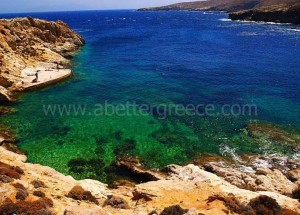
AYIOS SOSTIS BEACH ON SERIFOS: If we continue after the right turn for Lia beach, we will come to the hill from where Ayios Sostis double beach starts to become visible. The one beach looks to the south whereas the second beach faces the north.. A narrow lane of strand separates the two beach with a golden colored sand. There are a few trees for shade. The homonyms little church is built on the reddish colored rocks and under the church there is a small pier for people to tie their boats on or to dive into the deep blue water. Here we would like to mention that the southern beach is leeward whereas the northern beach has quite a rough sea.
PSILI AMMOS BEACH ON SERIFOS: Psili Ammos (Fine sand) beach is one of the most beautiful beaches on Serifos. In the year 2003 the beach won the first position among the best 20 European beaches. Its white sand looks like powder. It is restricted to a small bay with very shallow waters. There is a beautiful tavern for food and Psili Ammos beach is a playground heaven for couples with young children.
AYIOS IOANNIS BEACH ON SERIFOS: A small beach (approximately 4 kilometers) with sand and pebbles and the beautiful country church of Ayios Ioannis. The near-by beaches on this side of the island end here.
KALLITSOS BEACH ON SERIFOS: If you wish to go to Kallitsos long beach (18 kilometers long), which is also called Kentauros Beach, you must walk through the valley which is under the village. It is one of the most beautiful valleys on the island. Various types of fruit, vegetables and fruit bearing trees are cultivated on the left and right sides of the river.
PLATIS GIALOS BEACH ON SERIFOS: A lovely long (23 kilometers) sandy beach, located just before the Archangel’s Monastery.
ARCHANGEL’S MONASTERY ON SERIFOS: Archangel’s monastery beach is a very long beach close to Platis Gialos beach. You should also take a look at the Archangel’s monastery (See sightseeing on Serifos).
4. Sightseeing on Serifos
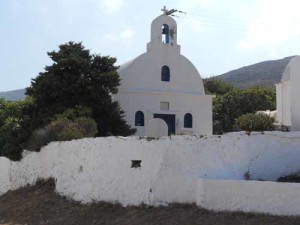
The Castle – The Monastery of the Archangels on Serifos: The Castle – Monastery of the Archangels is located 10 kilometers towards the North-East side of the port and 10 kilometers away from the capital city of Serifos, Chora. It is dedicated to the Archangels Michael and Gabriel. Its construction was based on an architecture concerning its guarding with a surrounding wall, 8-10 m high, and many small openings on it, the so called embrasures. In 1447, a small church was built having this date built-in on a slate, which was later transferred to the new temple.
In 1570 a Cypriot ship got away from the Turks and anchored at Platis Gialos. The icon of the Archangel was in this ship and the captain gave it as a gift to this small church. According to tradition, the monastery was built in the early 17th century. The miraculous icon of the Archangel made the monastery well-known not only in Greece but also in foreign countries. In 1659 it took the form of a medieval fortress, due to the pirates, and that’s how it is maintained until today. This is the place where the holy code is kept. A very narrow ladder, 4 meters high, leads to the low door which forces the visitor to bend while entering the corridor where the temple is low-roofed.
The main temple is of great architectural interest. It is triconch with one room and a dome. Its facade has a western aspect. Around it there are two stores with cells where monks, about 100 in number, used to live. The interior of the temple is filled with wall paintings of Christodoulos Kallergis of Mykonos. The hagiographies of the temple are attributed to the hagiographer Emmanouil Skordilis of Crete. He has also created the wall paintings which represent the battle between the archangel and the beast of the Revelation, the Dragon, which swallows kings and bishops, the horror of hell.
The center of the floor is laid with a marble plaque decorated with an embossed two-headed eagle and dated to 1659.
There are many votive offerings in the monastery. Among others there is a silvered plate offered by Alexander Ipsilantis in 1785. Remarkable heirlooms are kept in the monastery. Its library is a work attributed to the abbot Averkios Papalis (1909). On the 8th of November, the monastery celebrates while chickpeas and fried salted cod are offered.
The Venetian castle in Chora: When the Venetians arrived to Serifos they saw the Castle and the houses being ransacked. After the Nympheus treaty between M. Palaeologus and the Venetians, the Venetians Michelis – Ioustinianis occupied Serifos in 1296 and repaired the collapsed walls but only at the Citadel. This strengthening of the walls was enough for their safety. The particular, Venetian family dominated Serifos for 250 years with short intervals (1296 – 1538 B.C.)
After 1434, the 3rd generation of Michieli dominated. Their coat of arms exists even today. At first it had been placed above the gate of the Castle (Lotzia the Southern) but Karolos Rotas transferred it above his house door and is now owned by Emm. Magoula (Kastri), according to Tr. Evangelidis (page 67). Apart from the Michieli family, despots of the island had been for a short time, as joint rulers, Petros Ioustiniani (Guiustinian) and the noblemen of the Rinieri Minotto house, Ermolao Minotto, who brought great economic rise and changed the port of Serifos into a shipping communication station due to the island’s position and its wide mine exploitation.
Minotto died in 1376 and his daughter Alizetta married Simone Adoldo, Mcolo Adoldo’s son.
Ermolao Minotto came after Nicolo Minotto in 13 93. The Venetian palace, Varonia, used to be at the relics that lie today in front of Ag. Ioannis the Theologian.
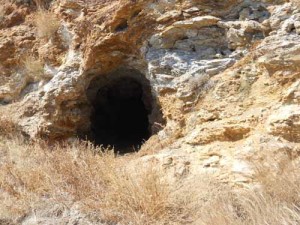
Koutalas Cave: It is located at the homonyms bay and it is also known as Stavrakopoulos cave. It is difficult to find. You will need a guide due to the many old and sank galleries.
It is situated among the bays Malliadiko and Koutalas. It was randomly discovered during mining activities. Em. Groman discovered it in 1893. The photographer Th. Fritanidis, from Ermoupoli of Syros, photographed the cave and the following were written in a newspaper of Syros: “At a depth of about 15 m,.a great hall similar to Fignal’s cave in Scotland was found. It has innumerable stalactites and stalagmites. Inside the cave there are domestic utensils, jewelry, earthen pots, animal bones, lamps in alcoves and other things.” Groman transferred many of the above to the offices of the company. However, his successors caused landslides while opening mining galleries and, as a result, the cave, which remains unexploited until today, was almost ruined. At a depth of 15 m there are stalactites and stalagmites of great archaeological interest. Ancient crystallized earthen utensils were found at the side niches of the cave and on its floor around the two small lakes that are formed, suggesting that the cave was used as a place of worship. Unfortunately, it was ransacked by the Gromans and later on by other investigators. Its entrance is blocked by a boulder. It was mapped in 1961 by the archaeologist Christos G. Ntoumas. A description of the cave was published in 1963 at the archaeological report No 18. It is declared as a Monument of Nature and Civilization. It has been proclaimed an archaeological site. Unfortunately today, the cave isn’t available for visits due to the landslides it has undergone. Now it awaits its exploitation.
The folklore museum in Chora: The Folklore Museum of Serifos was founded in 1976. In eight years time, simultaneously to the extensive maintenance of the building, the biggest part of the exhibits was collected by donations of the residents.
It belongs to the Serifians’ Association and it is the only one in the island. It was founded in order to save the traditional heritage of Serifos and to pass the message that the present and the future can be held together through tradition. It is housed in a building of noteworthy architecture in Kato Chora and it dominates the area while having a unique view to the light blue sea.
It contains articles that the Serifians were using in their everyday life. The museum also contains textiles, ceramics, porcelains, utensils and tools, local traditional clothes and other objects which represent the agricultural and household working of the countryside. In a separate hall there is a collection of rocks and semi-precious stones that have been found in the rich soil of Serifos. It is one of the few Museums that have a separate privately-owned space for hosting events. Behind the Folklore Museum there is a small theater with capacity for 300 people, where several cultural and artistic events take place (since the summer of 1995), which contribute to the further cultural upgrade of the island.
The old windmills in Chora:
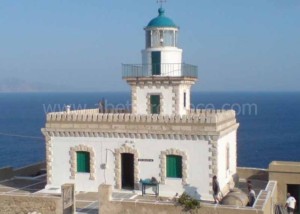
The church of Panayia or Xylopanayia in the area called Panayia on Serifos: It is located on the northern side of the island, at the little square of Panagia village. Its rhythm is byzantine (950-1050 A.D.) and it is situated 6 km north of Chora.
The temple ran as catholic of the monastery which was destroyed by the Venetian conqueror Nicolao Adolfo in 1393.
The Serifians call it “Xylopanagia” because of the many fights that take place during its festivities, due to the old custom according to which the one who will be the first to dance with his loved one under the old olive-tree of the town, he will get married during the year.
It is the oldest and most important byzantine church in Serifos and the only one having tiles. It was the first monastery on the island.
It has a dome and a double bell-tower. The arches of the sanctuary are semicircular and on the middle semicircle a built Episcopal throne is saved. The wall-paintings of the temple have almost worn out since there is no interest for their maintenance. It used to be decorated with wall-paintings of the 14th century which represented Ayios Prokopios holding a javelin and a shield, Ayios Eleimon and Ayios Ksenos, while the name of Ayios Potapios is also saved. On the fourth sphere of the Arch we can see Panagia with her hands raised. The subsequent representations show the Pantanassa (on the arch) and Agia Theofania and Agia Aikaterini on the northern wall.
Its icon screen is hung with offerings and has been replaced due to the wear and tear of time of the older orte. Interesting seem to be the silver cherubim with the Assumption of the Virgin on the one side and Ayios Georgios on horseback on the other and the savior, being showed full-length, on the clouds with the evangelists’ busts. Around the temple there are cells which are today let out to visitors. Around me temple there are cells which are today let out to visitors.
The mine installations close to Megalo Livadi
The Ancient spas in Megalo Livadi
The head quarters of Spilialeza in Megalo Livadi
The War memorial in Megalo Livadi
The Miner’s settlements
The Mine installations close to Koutalas
The Old woman’s castle
THE CASTLE OF GRIA (= Old woman’s castle): It concerns an ancient citadel or an autonomous fortified settlement at Koutalas bay, 228 m above sea level. Remnants of water-tanks, crumbling walls,
collapsed defensive turrets and foundations of small square areas are saved. In 1772, the Dutchman Pasch van Krienen discovered three tombs with funeral gifts, statuettes and coins during his excavations.
LIOMANTRA: On the route Chora – Meg. Livadi (at 5,5 km) we turn right towards Liomantra and at the end of the road (3 km) we meet ancient Cyclopean walls with hewn boulders. They probably belong to a citadel of the Mycenaean times.
KAMPOS: Leaving Kallitsos village and heading towards Galini, there is a vaulted erection-tomb at Kampos location. It can possibly be the tomb of a Roman centurion from whom the village Kentarchos got its name.
The Aspopyrgos (The white tower): It is the most well maintained and impressive monument on the island. It is situated about 8 km from Chora towards Meg. Livadi on the left side of the road at Asprogia. It is a round tower, built with pure white marble and has a height of 4,5 m. Its original height must have been even greater. It might have been a building of the later, classical times or the Hellenistic period. It has many similarities with the tower of Naxos. It oversees the entire southwest side of the island. It might have been a watch-tower or a guardhouse or something else. Its diameter is about 30 feet according to Tr. Evangelidis while G. Varlas quotes “This tower may not have been finished. This is.revealed by the marble paving stones lying on the west, outside and inside the tower. There might have been a lightning that crumbled part of the walls.”
On April 1772, Errico Leonrdo and Pasch van Krienen found ancient tombs with funeral gifts close to the tower and they plundered them (as Tr. Evangelidis and Fok. FGalanoScWrite in their books).
The monastery of Evangelistra Acroteriani
THE ANNUNCIATION OF VIRGIN MARY – EVANGELISTRIA: In the center of Kato Chora, at the marble-paved square, lies the Annunciation of Virgin Mary, Evangelistria. At one time there was Ayios Sozontas which nowadays is a chapel in the new temple. People started building it in 1893 and completed it in 1907. It is a pretty big and beautiful church. Its internal floor is made of marble and has an iconostasis which is builti There are four perfectly preserved icon screens of excellent sculptural art. The vespers service and the service of March 25th are festive since they coincide with the anniversary of the War of Independence.
At Kato Chora lie Ayios Antonios (opposite the folklore Museum), Stavros (=Cross) which is dedicated to the Exaltation of the Holy Cross and Ayios Ioannis (John) the Baptist which is located at Plakanos district.
The throne of the Cyclops in Koutalas: It is located at Mesa Akrotiri (= cape). At about 1,5 km before we reach Meg. Livadi we turn left and in 2 km, after we cross Evangelistria Monastery, we see the Cyclops’s Throne also known as Kanapes (= couch) or Psaropyrgos (= fish tower). The myth of Serifos being the land of the Cyclops has been hovering for centuries over the island, although Homer, in his poem “Odyssey” mentions that it is in Cicely. Serifos is the place where the giant Polifimos was blinded by Odysseus.
The Cyclops – Poseidon’s children – were the first who exploited the mineral wealth of the island and created an early culture which was later on bequeathed ta-juim$ps.The Cyclops’s throne consists of seven successive rows of enormous blocks gf stones that measure 3,60 x 0,95 x 0,30 m with a total height of 2,10 m. The dimensions of this rectangular construction are 8,85 m of length and 7,50 m of width.Tradition has it that this is the throne from which the Cyclops Polifimos threw the rock to Odysseus, during the escape of the king of Ithaca with his companions from the island at Koutalas bay.
THE CITADEL OF SERIFOS: People in Serifos, like the people on the rest of the Cyclades’ islands, built walls and made citadels on craggy and rocky hills for safety reasons since antiquity.
Triton Evangelidis mentions in his book “Serifos and the islands around it” that during his visit to the “Castle” in 1908, he only came in view of massive granite stones while there was “no other significant ancient piece of art” as he quoted.
There are fields studded with hundreds of cut out granite rocks on the S-SE side of the Castle. These rocks, or even smaller ones, were used to build the Castle of Chora which was the Citadel of Serifos. According to G. Varlas’ research, the Castle is marked with the numbers 1, 2, 2 A, 9 and 10 at the topographical diagram of Chora.
At number 1 there is its northern gate. While entering, on the right side we can see the date 1778. The entire northern side of the rocks is unassailable and therefore no walls were needed. At number 2, a water-tank was built on the northern side of Ag. Nikolaos’ church and earthen aqueducts have been saved on its north foundations. Number 2 and 3 shows the rocks which have an opening. This is the point the wall starts descending again towards the rocks where the church of Agia Varvara is built. It is likely that there was also a gate at the point where we enter the churchyard. From the mark 3 to 3A there is the SE entrance gate which is clearly visible until today. There is another gate from number 9 to 10 which was small but safe, without walls, due to the craggy rocks. The Central West gate of the Citadel, today’s “Lotzia”, lies at number 10 and leads to Lempidi district. This gate used to close with a heavy wooden door which prevented the enemies from going through it. Now it always stays open and leads to the square of Upper Chora. Above this gate and up to number 1 the rocks are craggy and! unassailable.
Varlas quotes “This is how we got back to number 1 from where we started, rounding off the perimeter of the rocks and those who ” have the chance to see for themselves the morphology of the place can understand that the Citadel of Serifos was almost unassailable”. Under the Citadel of Serifos there are more walls, probably dating from the Roman or Byzantine period. In addition, many blocks of the walls have been used for the building up of various houses. However, it seems that the damages caused to the wall during the Hellenistic or Roman times, forced the guards of the Macedonian-Ptolemaic or Roman occupation on the island to reconstruct it. They reduced its original length and from the traces of the new wall it is probable that it followed the route 4-4A-8-9 which means that they left out of the new wall the regions 4-5-6-7-8-9
STROGGILOS (= round) AND SOROS (= pile) TOWERS: These two towers are located near Galani village. If we want to see them, we have to walk on the side of Evrinos Mountain. A part of Stroggylos tower with a height of 2 m is saved, while there are only ruins of Soros tower creating a big pile.
Churches on Serifos island
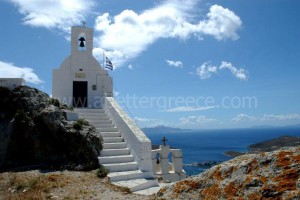
Most of the churches in the Castle were built during the Turkish domination.
AGIA VARVARA: it is the first church we come across on the south-east of the castle while we walk up one hundred steps on its northern side. There is also the chapel of Agios Savas. Its built date is unknown. A plaque mentions that it was renovated in 1890. The icon that goes on procession was built in 1864 with a silver case and represents Agios Savas and Agia Varvara.
CHRIST: Located on the west of Agia Varvara and is dedicated to the birth of Jesus Christ (1895). There lies also the chapel of Agia Sofia. It is a model of traditional architecture.
AGIOS KONSTANTINOS: Agios Konstantinos is situated one hundred and seventy steps higher than Agia Varvara. It stands at the highest point of the castle. It is a small vaulted church of the 19th century with a simple bell-tower, a small bell and a stone cross. On its northern side there is an old water tank. Here, one can enjoy the sun rise close to Naxos and set behind Oros. A marble slate at the steps of the entrance mentions: “Sacred to the memory of the compatriots who were subjected to horrible torture by the ruthless Venetian despot Nicolo Adolfo, were thrown off the northern battlements of the castle walls and found a deplorable death on 18-7-1393”. Signature: Serifians’ Municipality and Association 20-8-1995.
AGIOS GIANNIS THEOLOGIAN: It is situated right under the foundations of Agios Konstantinos. It is a basilica with two naves. Legend has it that Medusa’s head lies in the basement of Theologos. A marble slate with a three-masted schooner is placed on its facade, above the door. According to tradition, it was built in 1600 A.D. This is the temple that the icon of Agios Antonios Pasuis came from and is now located in the Byzantine Museum. Opposite Theologos lie the ruins of Agios Georgios, who was nicknamed “Marmakas”.
AGIOS LEFTERIS (Lempidi district): The ; church is very old. It is situated between the districts of Lempidi – Tsigouri at Chora. It has two bell-towers in two arches and two I doors. On May 22,1821 the flag of the Greek 111′ War of Independence was raised there. One of its bells was an offer by the French consul BjE in 1610. On the right side of the door below, an embossed little horse is carved. Right across the way, there is the Spanish consulate.
AGIOS GEORGIOS (Plakanos district): A built-in slate mentions that it was renovated in 1822. It is arched with a bell tower and has an embossed figure of a small ship above its entrance. ‘
AGIOS IOANNIS: It is located opposite Agios Georgios at Plakanos (19th cent.).
AGIOS ISIDOROS: It is an arched church with a bell-tower. We come across it as we walk up the old stone-road from Livadi towards Chora (19th cent.). Its existence was registered during the inventory of the buildings in 1670. The teacher of Othonas University, Ludwig 8th, informs us that it was built by Sofia Makri. There are two versions concerning its name. According to the first one, during a pirate raid on the island, those who didn’t manage to lock themselves up in the Castle of Chora, found a shelter in the church and the Saint’s Grace, just like iron, withstood the invasions of the pirates. Therefore, it was named “Isidoros” (=made of iron). According to the other version, it was built by Sofia Makri when she dreamed of the location of the underground miraculous mineral water spring. The Saint told her that she should reveal it so that the sick people could heal. Thus, since its water is ferrous, it strengthened like “iron” those who suffered and so the name “Isidoros” prevailed.
5. Villages and settlements on Serifos
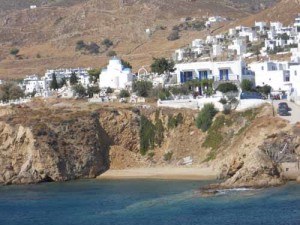
Livadi: This is the area where the port of Serifos is located. In the ancient years, this little village used to be called Vathi. Today as you arrive on the small island of Serifos, Livadi welcomes you with its 2,5 km long sandy beach, its restaurants, taverns, rooms to rent, hotels, information office, rent a car offices and travel agencies. The port of Livadi and the beach is safe from north winds and is one of the most popular archorages of the Cyclades. Livadi used to be the head of the mining company and a place of ore shipping with a bridge on the end of the port, which has now been destroyed. This is also the point where all the roads to different villages start.
Chora: Chora is the capital of the island. It stands among the most imposing ones in Cyclades. It is 5 km far away from the port. It is amphitheatrically built on the hill and offers a view from everywhere and towards all directions. This medieval settlement with the stone-paved little streets, the windmills (today, two of them survive with the remains of others) and the houses of marvelous architecture remained intact through time. It is considered to be a model fortified medieval settlement having the ruins of the Castle on its top.
Many notable people characterize it as artistic and cultural and have it chosen for their vacation, claiming that it has no relevance to the other islands. Chora comes into view from the hill, charming and ravishing as it is, while changing shades like the mountain does according to time.
Its houses are built on the cone-shaped rock. The traditional Cycladic rhythm is in complete harmony with the natural landscape. The flat white narrow roofs, the whitewashed steps, the arches, the multi-colored wooden doors and windows dominate the place. The architectural character of the houses differs only on the new constructions. Since the Frankish Rule, the houses that lie on the periphery are built to be adjacent, in order to create a protection wall able to resist the pirate raids. They have small windows or no windows at all. When the danger of the pirate invasions decreased, people started to make windows and balconies with French windows.
Its quaint alleys are very narrow and mazy with white gaps and small yards. In fact, they are so narrow that one can hardly cross them with another person right next to him and it is true that there are only a few alleys where two people could walk next to each other. Its small churches have white or light blue tombs and single or double bell towers. All the above characteristics compose a rare work of Cycladic architecture.
Agios Athanasios is the Capital of the island at the square of Pano Chora. It must have been built many hundreds of years before 1821 when the Patriarch Grigorios E’ gave permission to collect money for its repair. Works by the Serifian hagiographer Apostolos Grekos, a wonderful woodcut church icon screen with the Assumption of the Virgin, votive offering by Georgios Groman, and an epitaph of Russian making dedicated to Agios Georgios Plakanos by Stylianos Potiriadis and brought here by the parish priest papa-Anastasios Evgenios survive today.
On January 18, the festive mass, sacred to the memory of Athanasios and Kyrillos, is celebrated.
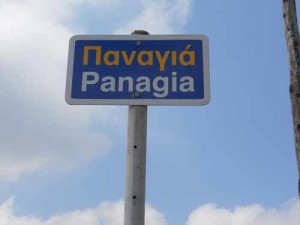
Panayia: The small village called Panayia is named after its church, which is the most ancient church on the island of Serifos. The village is 350 meters above sea level. In 1754, the first houses were built around the homonymous Byzantine monastery of Panayia. Even more houses were built, after the Greek war of Independance in 1821, by refugees of Peloponnese, by islanders hit by Ibrahim’s fleet and by Serifians.
Galani Serifos: The village was named after the ancient mines of Galinitis that were found nearby. Very few people remain here all the year round nowadays, while it used to be populated after the 1821’s revolution by refugees and inhabitants of other small villages.
Sikamia: It is the haven of the villages Panagia and Galini with a great beach, trees and a restaurant. The natives used to call it Sikamia. Its name comes from sikaminies (mulberry trees) which probably lay here, since it is said that during the Frankish rule the production of silk took place at this area. Note: You can also visit all these villages and beaches starting off at Chora. Returning from Sikamia using the same road we can go right until Megalo Livadi, go through Koutalas, Ganema, Rammos and end up again in Livadi (port) from where we set off, meaning that we will complete a road circle of the entire island. This circle could be made backwards as well: Livadi, Rammos, Vagia, Ganema, Koutalas, Megalo Livadi, Ag. Marina INTERSECTION right for Chora Livadi and left for Sikamia or the Archangels’ Monastery, Kentarchos, Psilli Aminos, Ag. Sostis and Livadi.
Kastro Grias (The old woman’s castle): THE CASTLE OF GRIA (= Old woman’s castle): It concerns an ancient citadel or an autonomous fortified settlement at Koutalas bay, 228 m above sea level. Remnants of water-tanks, crumbling walls, collapsed defensive turrets and foundations of small square areas are saved. In 1772, the Dutchman Pasch van Krienen discovered three tombs with funeral gifts, statuettes and coins during his excavations.
Megalo Chorio:
Megalo Livadi: Megalo Livadi is located around 13 kilometers towards the south west side of Chora. Despite the fact of being a remote and quiet area and beach, there are a few taverns nearby that usually have local people there; some of them have tables right upon the beach, which allows tourists to enjoy having a drink without leaving this awesome vibe of the natural environment. Some other taverns also serve good food dishes, as well as the refreshments. The truth is that this village itself counts on a good variety of interesting cafes and restaurants.
Although today it has only 50 inhabitants, in the past it was quite highly developed in financial terms, due to the exploiting of minerals. In fact, Megalo Livadi was founded because of the bauxite mines located nearby, as the mining industry was on its highest peak around 1880 and 1890, when this village was born.
Koutalas: Koutalas is a sea side settlement, located on the southwest of Serifos. It has a very few inhabitants and it is ideal for a quiet time on your vacations or visits from other settlements or villages. Koutalas is not a that much of a touristic spot, but it counts on some interesting attractions. There are a couple of beautiful beaches located in th bay of Koutalas..
Livadaki:
Kiklopas:
Kallistos: A quaint village, amphitheatrically built between two slopes filled with vineyards, olives, figs arid almond-trees. At first it was built at a higher place with the name Ksero Chorio (dry village). However, it was ruined during the pirate raids (8th – 10th A.D. cent.) and was built at its today’s location during the Greek War of Independence of 1821. Its name might originate from “Kalliston” (=beautiful). A wide stone-paved little street crosses the village. At its centre there is a spring. If you want to go to Kentarchos beach, you will walk through the valley which is under the village. It’s is the most beautiful valley on the island. Various types of fruit, vegetables and fruit-bearing trees are cultivated on the left and right sides of the river.
Ganema:
6. The history and mythology of Serifos
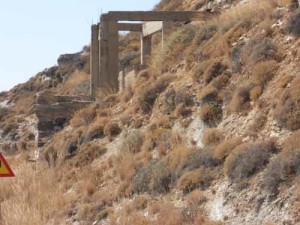
The story of Perseus certainly belongs to mythology. And myths remain myths. However, the historic events interest us more than the myths concerning Serifos. The first inhabitants of the island, before 1000 B.C., were the Leleges, the Pelasgoi and the Kares from Asia Minor. This is what the two great historians, Th. K. Argouzakis and Trifon Evangelidis, claim. The Kares are also mentioned in the works of Thucydides A’8-, Herodotus A’171 and Diodorus of Rhodes E’20 and 89. They call them professional conquerors – pirates.
The most ancient findings of ruins are located on the western part of the island. Therefore, this is where the fist inhabitants were settled, followed by the Cretes of the Mycenaean period (1700 – 1750 B.C.) and the Phoenicians. The Phoenicians were the first who started the exploitation of the mines at the location Moutoula Galanis. After them, the Mycenaeans first found Serifos, during their exodus to the Aegean Sea (1450 – 1400 B.C.) and held dominion over that sea until 1200 B.C.
According to documented records by G. Varlas (researcher, hiker and author of Serifos) the knowledge of metallurgy in Serifos dates back to early years and, as he writes in his book (1998), it is about time for Greek archaeologists to give their attention to Serifos before valuable piece of evidence is lost.
In the mid 7th cent. B.C., Serifos became the colony of the lones from Greece, with Eteoklis being their leader. In 650 B.C. the people of Serifos abolished the existing monarchy and established “Democracy together with Delos, Naxos, Mykonos and Tinos. According to Thucydides, all these islands formed the Amphictyony of Delos. In 530 B.C. Serifos cut its first coins while it was autonomous. During the Persian invasion, Serifos was one of the few islands that denied earth and water. What’s more, in the battle of Salamins (480 B.C.), it assisted the Athenians by sending them a pentikontoros (ship with 50 oars overall) and thus Serifos became a respectable and important ally. The people of Serifos participated in the Athenian alliance as well as to the battles of Nemea, while holding an important position in the political and religious meetings of Delos. In 404 B.C, during the Peloponnesian War, and while being allied to the Athenians, Serifos was beaten by the Spartans who forcedsligarchy upon Serifos.
In 378 B.C, the Athenians dominated the Aegean and according to Kononas the Cyclades became autonomous.
In 363 B.C, the Macedonians with Philip 2nd conquered the Cyclades until after Great Alexander’s death, followed by Ptolemies, Macedonians and Ptolemies once again until 203 B.C. when they were forced out by Philip 5th.
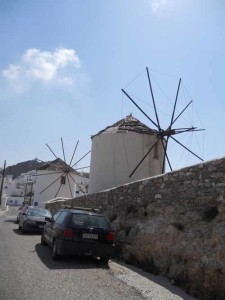
The Romans ousted the Macedonians and founded a new state, “the Commonwealth of the islands”, which was preserved from 200 B.C. until 166 B.C. when it was disintegrated. Each island became independent. Since 146 B.C. all the islands were dominated by the Romans. Serifos had been under the Romanian domination for 560 years (166 B.C. – 395 A.D,^ like most of the Cyclades, and was named as a place of exile. At the same time, the history of Serifos was scarred with raids of pirates, having as a high spot the years of the pirates of Cilicia.
From the 4th century A.D. to 1200, the information we acquire about Serifos by Fokion Galanos is slim. In the 9th century, the Saracens prevailed (there is a place-name called “the Saracen’s” in Serifos).
In the 13th century, the pirates managed to rule the islands since the battle of the Byzantium between East and West didn’t allow the emperor, Andronicus Palaeologus, to protect them. The inhabitants of Serifos took to mountainous places in order to defend themselves by pirates such as Venetians, Catalans, Africans and Genovese.
In 1206, Venice issued a proclamation by which the noblemen were given the rights of domination over the islands that they would occupy. The Serifians, “as pirates”, resisted but in 1296 the Ghisi brothers together with Giustiniani, Domenico Mitsieli ruled the island. In 1323, the Bragadini succeeded them while the Venetians-Genovese battle continued at the Cyclades until 1335 when a treaty was signed and Serifos was assigned to Ermolao Minotto as a Venetian possession.
The island thrived economically. The safety of the inhabitants was taken upon the Venetian noblemen. Minotto brought hundreds of slaves who worked ‘ with the locals and brought into operation again the mining activities of iron, after a long time of idleness. He also gave dividend of his profits to the local owners of the mines. Many Serifians became rich while making their island one of the wealthier in archipelago. Niccolo Adoldo succeeded Minotto who committed crimes against the Serifians. The Venetian Senate condemned him and forbid his return to the island. It is claimed that, he used to come and take money with Crete mercenaries while killing slaves and Serifians. The prosperity of Serifos was gone with Minotto. Turks and Venetians fought until 1430 over Serifos while sultan Mourat B’, with a new treaty, allowed the Venetians’ domination.
In 1434 A.D. the Michieli family built the castle of Chora (the capital) which dominated for one hundred years on the island.
From 1469 to 1502 Turks and Venetians fought again over Serifos. On July 13, 1538 A.D. the Turk Hayreddin Barbarossa came from Andros, occupied Serifos and imposed taxes and misery. Some families went to Folegandros island and founded the settlement called “the Serfiotika.
During the Venetian invasions, the Serifians were obligated to protect the Turks and when a Turk was captured they even paid ransom for his release. In 1680 the island was hard hit by a plague epidemic during which many inhabitants died. After that, a new great distribution of land fit for cultivation followed. New measuring of land were made, using a new unit of measurement called “the Venetian rope”.
The paths changed and new paved ones were created, which still have the same form until today. In the early 18th century, the vineyards covered the largest part of Serifos. A great exportation of wine and vinegar was made to the islands of Hydra and Syra (Syros). During the Turkish occupation, there was a period of time (1770-1774) that the Russians ruled after their victory against the Turkish fleet and the naval battle of Tsesme (28 June 1770). On July 10, 1770 Orloff reached Serifos. On July 21, 1774 a new treaty between Russia and Turkey was signed followed by another one (treaty of Aynali Kavak) on March 10, 1779. Mtl§r islanders became Russian subjects and went to Odessa. During this half of the 18th century many Serifians left for Iasi of Moldovlachie (Moldova and Vlachia). In 1817, Loukas Livanios, son of Theodore Livanios – member of the Society of Friends, opened the first school in Serifos.
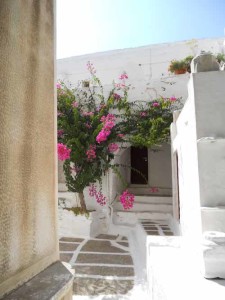
In the mid 1820s Alexander Ypsilantis announced his first great battle against Turks. Themelis D. was the first who assumed the command regarding Serifos, Kea, Kythnos, Syros, Tinos and Mykonos. The ones who followed were Leftikos, Gryparis, Protopapas, Sgourdeos, Kyritsis, Paleos and others.
On the 21st or 22nd of May 1821, the local members of the Society of Friends and the Serifians raised the flag of Revolt at the holy temple of Ag. Eleftherios in Chora.
After the A’ National Assembly’s voting, the Turks were deported and Serifos became a community ruled by the elders B. Gryparis and N. Kyritsis, followed by I. Papadopoulos, A. Livanios, G. Protonotarios, I. Kontes, L. Gryparis, B. Rotas, N. Gryparis and N. Logothetis.
Up to 1933 people suffered a great deal until the French and English of the Mediterranean succeeded in annihilating the pirates. However the smuggling replaced the piracy. Many elders became tools of the smugglers and claimed the protection of the consuls on the island. After the smuggling period the seamen went in for merchant shipping. Some of the old seafaring families in Serifos are those of Livanios, Makris, Kamoudis, Lieros and Raviolis.
On April 15, 1833 after Otto’s election as King of the Greeks, Serifos became a 3rd class municipality. The decree assigned the Section of an elders’ Council and a mayor’s election which was validated by the King.
In 1834, the first elected mayor was Ioannis Leftikos or Lampadarios from Roumania. He held all power and appointed the first public employees: Vikentios Rotas (customs supervisor), Ioannis Mavroudis, Ioannis I. Delagramatikas (administration secretary) and G. Speras (bailiff).
Serifos had 1932 inhabitants. On March 1837 there were second elections with 2200 inhabitants and K. Livanios was elected mayor. On June 1938 the Administration of Syros was founded, where Serifos belongs too. On April 1939 the 3rd class County Court was established having as a magistrate Lampadarios who was elected mayor in 1841. The following elected mayors were N. Sgourdeos (1845), N. Kyritsis (1849) and B. Rotas the next four-year period. In 1849 Serifos had 2506 inhabitants.
When G. Protopapas was a mayor (1958), the first elementary school and building was founded together with the wharf, the road Plakes which leads to Mega Livadi and the water tank inside the torrent of Petrias.
In 1868 G. Protopapas (primary-school teacher) had been the general secretary of the Cyclades prefecture. He left a-remarkable library to his nephew and teacher, D. Rotas. Since 1865, when I. Helmis was a mayor, the exploitation of the mines was initiated again (after its termination during the Venetian domination). To be exact, the mine activities were initiated during the decade of 1880 by Greek and foreign businessmen and were shut down on July 1st 1963.
SERIFOS IN GREEK MYTHOLOGY
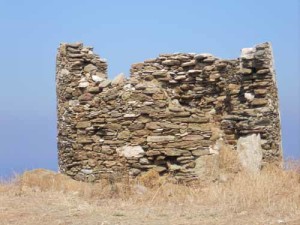
According to mythology Zeus, the father of gods and people, was involved in war with the great Titans, for the domination of the skies, resulting in the sinking of Aegiida and the destruction of the entire mankind. The only one who survive was Deucalion with his family and their ark and later on with his wife, Pyrra, the created again mankind.
Serifos, by mythology, was one of the islands that came into being after the sinking of Aegiida. In the past, it was the top of a mountain filled with many tree and forests, bright green ravines and valleys, wonderful climate and wild horse on its hills. All the above were the reason that the king of Boeotia, Magnes, son of Aeolus and heir of Deucalion, chose Serifos as the land where his two son Dictys and Polydectes, would reign. These were the first settlers and kings of Serifos where Perseus grew up. However, the question is how Perseus got to Serifos in the first point, We have written this story below.
THE ORACLE AND PERSEUS’ BIRTH
At that time, Acrisius with his two daughters, Danae and Evareti, was reigning over Argos in Peloponnese. Since Acrisius wanted to have male descendant, he went to consult Pythia at the Oracle at Delphi. There, he was told that Danae would give birth to a baby boy who would one day kill him while achieving a much greater fame than his own father. Acrisius was very disappointed by this news, he returned to Argos and in order to prevent his daughter Danae from getting married, he imprisoned her with her nurse in an underground chamber. Zeus, impressed as he was from Danae’s beauty, got into her room through the skylight in the form of a shower of gold and mischievously impregnated her. Soon after that a beautiful boy was born who kept growing up in that chamber. At some point, Danae’s father, king Acrisius, after hearing the baby’s cry, he killed his daughter’s nurse and locked Danae and her son in a big wooden chest and cast then away into the sea of Nafplio believing that they would drown or that the would decide for their fate. The powerful Zeuscalm the sea down and led the chest to the small island of Serifos using the wind.
DANAE AND PERSEUS AT SERIFOS:
While Dictys (king Polydectes’ brother) was fishing with other fisherman at some shore of Serifos, they found the chest, opened it and faced beautiful Danae with her baby. Dictys might have been living in the great “Cyclop’s cave” since the chest was found at its coast. Afterwards, both Danae and her baby were taken in at the palace where Polydectes fell in love with Danae but kept it a secret. The years went by and Perseus grew up while Polydectes passion for Danae became more intense. One day Polydectes decided that he wanted to get married to Danae but he had to send Perseus away since he was opposite to this marriage.
Therefore, Polydectes hatched a plot: he pretended that he wanted to propose to Hippodamia, the daughter of king Oenomaus of Ilida. The gifts he would bring to Oenomaus should have been offered to him by his subjects. Everyone would bring him a horse. However, Perseus didn’t own a horse so he bragged that he could bring him as a gift the head of Medusa, which was one of the three Gorgons. Polydectes gladly accepted the gift feeling confident that Perseus wouldn’t succeed and as a result he would get rid of him.
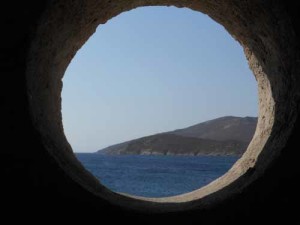
The question lying here is why Perseus decided to offer to Polydectes the head of Medusa. The reason is as follows: According to litterateur • Ovidios, Medusa was a very pretty girl with long hair which Athena decided to change into snakes to punish her after finding out that Medusa allowed Poseidon to rape her in Athena’s temple. In addition, according to many drawings, Medusa appeared to have the body of a horse from her waist down. Therefore, Perseus thought to offer to Polydectes the most unique horse man had ever seen.
Perseus got on a boat and left Serifos. While travelling he met Athena and Hermes who had decided to help him. They told him that in order to kill Medusa he needed the following: Hades’ helm, the magic sack to safely contain the great head, winged sandals to fly to Medusa who lived on a rock in the middle of the sea, the polished shield through which he would see Medusa’s head (because whoever came face to face with her turned into stone) and finally the sharp sword or billhook, the “Arpin”.
Painting of Caravaggio Medousa on a shield Therefore, he was taken to the Nymphs. They armed him with Hade’s helm of invisibility which allowed the one who wore it to see what he wanted, the winged sandals and the sack. Moreover, Hermes and Athena provided him with a powerful weapon made by Hephaestus, the “Arpin”, in order to decapitate Medusa. Athena guided Perseus to Graeae (which means “old women”) who were Enyo, Pephredo and Deino. They had white hair and knew where their sisters, Gorgons, lived. These three Graeae lived in a pitch-dark cave at Kisthini, close to Hades at the west of the world, guarding their three sisters, Gorgons, and making sure that nobody would ever go near them. They had to share one eye and one tooth among them which would be used by the one that would guard the Gorgons, while the other two would sleep. However during the passing of the eye and the tooth from one to another none of them was able to see.
This was the exact moment that Perseus chose, coached by Athena and guided to the cave by Hermes, to snatch the eye from them and force them to tell him the whereabouts of their sisters Stheno, Euryale and Medusa lived. After acquiring this valuable information, Perseus reached the other side of Kisthini where Gorgons lived. It is true that they were as beautiful as their mother Ceto. Hesiod writes that Poseidon, crazy as he was about Medusa’s beauty, often went to the bright green plain to sleep with her.
Being helped by gods, Perseus came upon the sleeping Medusa. While approaching, he held over her his polished shield, which acted as a mirror. Medusa woke up, saw her reflection on his shield and turned into stone while Perseus cut off her head using the sharp billhook “Arpin” Hermes had provided him with. As a result, Medusas face was imprinted on Perseus’ shield and from her mutilated neck sprang her two children: a winged horse, Pegasus, and a giant, Chrysaor (meaning the one with the gold sword). According I to another source Hippos was also born.
Perseus wore Hades’ helm of invisibility and flew away with his I winged sandals. Medusa’s sisters tried to pursue him but in vain. Another version is that he rode Pegasus and took off. He turned all his enemies into stone using as a weapon the Gorgon’s look, which was powerful even after her death. He crossed seas, flew over Libya and exhausted as he was, asked giant Atlas to provide him with shelter. Atlas refused and Perseus transformed him into a mountain. Then he flew over North Africa and the Nile falls and landed on Ethiopia at the kingdom of king Cepheus and her wife queen Cassiopeia.
The palace was overwhelmed with grief and sorrow because of Cassiopeia who bragged that her daughter Andromeda was much prettier than the Nereids. As a result, they didn’t revenge upon the queen but upon her beautiful daughter Andromeda. So, the Nereids’ father, Poseidon, assigned the destruction of the land to a sea Dragon. The only way to prevent this was to sacrifice the girl to the monster and therefore Cepheus tied her daughter to two wooden poles on a rock.
That was the time that Perseus arrived. After finding out about Cepheus’ misfortune, he requested to take him to the shore where Andromeda was about to meet her doom. When he faced her he was so dazed by her beauty that instantly asked Cepheus to promise him that he would let him have his daughter if Perseus saved her. Cepheus accepted. Then Perseus grabbed his “Arpitf’ and after a hard-fought battle he cut the Dragon’s head off, whose blood painted red the rocks of the shore.
This was how Perseus married Andromeda, in spite of the fact that Cepheus knew his brother, Phineus, also wanted Andromeda and was annoyed that Perseus was illegitimate. In honor of Perseus games were arranged.
One of these games, “the discus throwing”, was unknown at Perseus’ home and therefore he asked to have as a present the discus which was rocky and shiny. After that he took his way to return in order to be in time for Polydectes’ marriage.
THE RETURN TO SERIFOS:
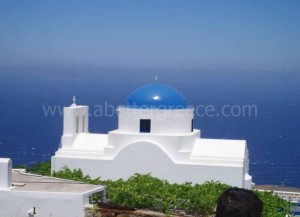
When he returned to Serifos he was informed that Polydectes had tried to rape his mother, Danae, who hid herself in a temple and begged the gods to protect her. Then Perseus attended the premarital feast at the palace where he whipped Medusa’s head out of the sack and showed it to everyone. They were all turned into stone, even many of the people of the island that had come to admire the trophy. As a result, the bright green island of Serifos was covered with stones and rocks. Perseus then handed over the royal throne to Dictys (Polydectes’ brother), let him have Danae as a wife and set off for Argos with Andromeda. Before setting off he gave Gorgon Medusa’s head to Athena, who nailed it on her shield, and returned the sandals, the helmet and the sack to Hermes. According to Apollodorus, at this point, Perseus’ achievements stopped. Thereafter, he reached Argos where Acrisius had abdicated from his throne and gone to Larisa because of his fear that the oracle of Delphi might be fulfilled.
He fortified the acropolis on the rocks of Mycenae with the “Cyclopean Walls” and was honored as a founder and hero by the inhabitants who had already forgotten Mycene, Inachus’ daughter, who had first built Mycenae before him.Consequently, Perseus was honored not only in Serifos but also in Argos, Mycenae and Egypt and with Andromeda they always shined together.
This myth is famous and widespread around the world. Andromeda symbolizes the erotic desire. The couple’s history has inspired many litterateurs and artists. Even the cinema gave us movies like Alberto de Martino’s “Perseus” (1962) and Desmond Davis’ “Choc de Titans” (1981). In addition, there is Lully’s opera “Perseus” (1682). Perseus’ presence is rich in works of art in many places such as Luvre, where we can see Tichiano’s art or in St. Petersbourg (16th century) where we find works of A. Coypel (17th century) and P. Puget (1684). In Florence one can see the famous Medusa’s he’ad (1596-98) made by Caravaggio and in Palermo, at the metope of the temple of Selinus (6th century B.C.) Medusa’s decapitation is featured while there are many more.
| Perseus and Andromeda had seven children: Perses, Alcaeus, Sthenelus, Heleus, Gorgophones and Electryon. (The encyclopedia PVRSOS, volume D, page 643, published in 1929, mentions Perses as Perseus, who seems to be the founder of the Persai, Heleus as Helenus and son Gorgophones as daughter Gorgophone. What’s more another son is mendoned. Mestorl From Perseus, Zeus* son, descends Heracles’greal generation. Heracles was also Zeus’ son. When Perseus passed away, gods didn’t send him to Ades but to the stars. They also placed Andromeda and her parents Cepheus and C’.issiopeia among the siars. Therefore the constellations of Perseus, Andromeda, Cassiopeia and Cepheus were created while their story was impressed on the vault of heaven. |
The GORGONS were three: Stheno, Euryale and Medusa, daughters of Phorcys and Ceto. They had golden wings, copper hands, tusks and snakes on their heads while with their look they could turn whoever faced them into stone. Of the three, only Medusa was mortal while the other two were ageless and immortal. According to Hesiod, they lived on the west side of the world, above the sky close to Hesperides.
THE MINES OF SERIFOS
Iron and copper mines existed in Serifos since the antiquity. The mining activities started during the first Cycladic times, 3rd B.C. millennium. The first concession for the mining of magnetic and carbonic iron was granted to the “Greek Mining Company” in 1869 by Otto who used a royal decree. This company went bankrupt and in 1880 the mines were bought by the French Mining Company of Lavrio, which was named “Serifos-Spilialeza”, having as founders rich Greeks from Constantinople with the help of the Ottoman Bank which had British, French and Ottoman interests. It remained active until 1883 but then it was also closed down due to bankruptcy. In 1884 it assigned the contract work of the mines to the German mineralogist Emilios Groman (Emile Grohmann). He founded a small company and merged it with the bankrupted “Serifos-Spiiialeza”, which already had mining foundations on the island. He exploited the mineral wealth of the island and in exchange he gave a wage to its owners and a symbolic amount of money to the Greek state. In a publication of the Greek Ore Miners’ Federation, the veteran miner G. Livanios, based on older people’s testimonies, mentions the following:
“Working conditions for the ore miners, during that time, were barbaric and cruel. They were exposed to the sun while working. At dawn they had to be at the entrance of each gallery and when the sun set they stopped working. They could enjoy the sun only on Sunday because they struggled for a wage that was just enough to live on”.
NOTE: Giorgos Livanios was born in 1920 and was president of the Miners Union from 1958 to 1960.
During Emilios Groman time, 2.800.000 tones were extracted. He died in 1906 and was succeeded by his son Georgios Groman. It is said that a big part of the minerals was exported to Germany having as destination its polemic industry.
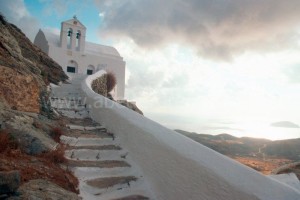
The old Serifians claim that “The German metal used in both World Wars was extracted from the bowels of the island”.
During 1914-1916 60 workers lost their lives in the rnine galleries. The Serifians used to work for 16 hours each day, even though there was a law for an 8 hour work. In June 1916, the Union was founded while instigated by K. Speras. On August 7, 1916 the workers denied to load Manousi ship which had as a destination Glasgow or Germany. They demanded an 8-hour job, wage increase and security measures. The magistrate of Serifos, D. Kontos, denied signing a telegram to the Ministry of the Interior, mentioning the workers’ strike and the setting on fire of a warehouse, sent by P. Vassos, the president of the community and the local warrant officer of the gendarmerie.
This telegram was the cause for sending a detachment to the island from Kea, with 10 or 12 gendarmes and the lieutenant of the gendarmerie Chrisanthou in charge, so that the loading of the ship would be ensured. The detachment reached Serifos in the morning of August 21.
Chrisanthou assaulted whoever stood his way, while he was headed from the port to Meg. Livadi. When he arrived he imprisoned K. Speras and the Union’s leadership. Then he went to the strikers who were on the loading bridge on the right of the beach (the head quarters is on the left) and gave them 5 min notice to load the ship. After these 5 min he shouted “in the name of the king” and shot them in cold blood. Themistoklis Kouzoupis, Mich. Zoilis, Michalis Mitrofanis and Giannis Protopappas were killed. A free-for-all followed, with more than 500 strikers with women and children aniong them.
There were tenths of injured people together with the gendarmes, two of which died.
The lieutenant of the gendarmerie, Chrisanthou, and the policeman of Serifos Giannis Triantafillou were stoned to death. Triantafillou was pushed of the loading bridge and fell into the sea. According to the local version, it was a woman who crushed the lieutenant’s head. K. Speras, who had just gotten out of jail, tried to hold the crowd, just like the priest Giannis Rotas did. The fight stopped when K. Speras took a French flag and shouted: “In the name of the French Democracy, put your weapons down”.
The administration and some of the workers were imprisoned in Syros. The wages were increased and the 8-hour work was settled for the underground jobs in 1925. The mines vegetated until 1934.
In 1933, Emilios, Georgios’ son, took over the administration of the mines. In 1943 he became officer of the Germans and after the end of the war he was sentenced as a war criminal and disappeared. After the Groman’s departure, the exploitation started again in 1954 by the company “Mediterranean Club of Trade and Industry” represented by Apostolidis who was the vice-president of Karamanlis government. However, in 1963, it suddenly went bankrupt and all those who were in charge disappeared without paying the miners. Since then the mines were shut down. In July 20 1963, at least 300 miners, who were owed the wages of 6-7 months, marched from Meg. Livadi towards Chora (3 hours way), where the company’s offices were situated, in order to find its manager. However, he had already left with the last boat that loaded the last shipment from the island. Today, everything is in ruins at Meg. Livadi: buildings, wagons, half-collapsed loading bridges and galleries’ entrances. Even the Groman’s head quarters, a neoclassical building, is about to completely collapse. The owners, Aggelopoulos family, recently donated it to Serifos Municipality but it might be collapsed until it is repaired.
7. Rent a car on Serifos
| COMPANY NAME | TYPE OF BUSINESS | LOCATION | TELEPHONE NUMBER |
| Kartsonaki company | Rent a car / motorbike | Livadakia | +30 22810 51534 |
| Coralli | Rent a car / motorbike | Livadi (main port) | +30 22810 51488 |
| Blue Bird | Rent a car / motorbike | Livadi (main port) | +30 22810 51511 |
| Anastasios Politis | Rent a car / motorbike | Livadi (main port) | +30 22810 51116 |
| Tomaso – Rent a car | Rent a car / motorbike | Livadi (main port) | +30 22810 52000 |
8. Useful information about Serifos island
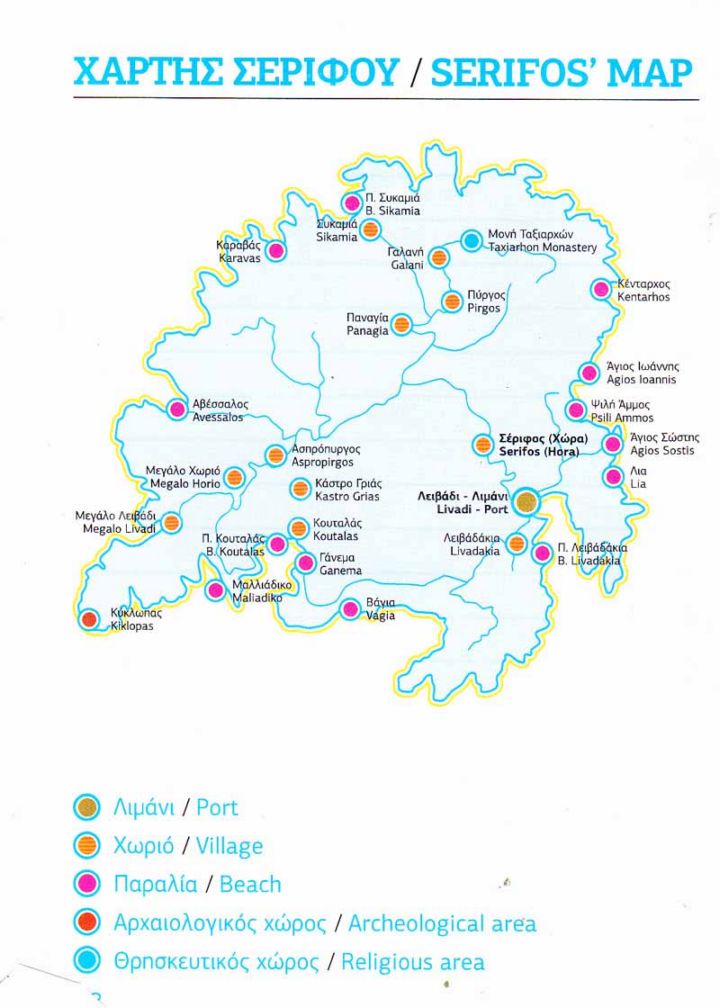
Serifos is located at the South West part of the Aegean Sea. The name of the Aegean Sea originates from the king of Athens, Aegeas, (according to the relevant myth) or from the ancient city of Evia which is called Aeges. Serifos has a total area of 77,8 sq. km. It holds the 42nd place, in terms of size, among the Greek islands and is 72 n.m. far from Piraeus. The trip from Piraeus on a conventional boat lasts 4,5 – 5 hours, while on high speed vessels, like High Speed, it takes about 2 hours and 20 minutes.
It’s an almost circular island with a perimeter of 21 n.m. (approximately 37.680 m.) and a diameter of 13 km from SW (Cyclope cape) to NE (Mavro Vouni). In addition, its diameter from NW to NE (Kefalas – Helandros cape) to SE (Aminon cape at Diacofti) is approximately 11 km. The total coast length is 81 km. Its shape looks like a frog, which was worshiped in antiquity and thus it decorated the coins of Serifos, while being embossed on them, 2.500 years ago. It belongs to the western Cyclades, facing Kythnos on the North, Sifnos on the South and Syros and Paros on the East. Around it there are many small islands. The biggest one is Serifopoula on the North followed by Piperi or Kalapodi and Vou, Garbia on the East and Glaronisi on the South.

THE CYCLADES: The administration of Serifos belongs to Cyclades prefecture with Ermoupoli of Syros as a capital and is a part of Milos province. Kallikratis didn’t change anything. Among the 24 large Cyclades islands it holds the 14th place in size with a population of 1262 (681 men – 581 women). Its economically active population is 433 out of 1262 inhabitants. “Unfortunately we grew old”. Up to the age of 19 there are 150 inhabitants while from the age of 65 and above the number of people is 1389. In 1772, Pasch van Krienen visited the island and informed as that there were 36 villages. Today, there is a kindergarten, an elementary school, a high school with lyceum classes and one TEE (technical education school).
MOUNTAINS:
The highest mountain is Troullos with its two peaks at 587 and 583 m. (according to the mapping of the island in 1976 by the Geographical Army Service). Petrias 570 m., Diasella 519,5 m. and the peak of Oros at 509 m. follow. There are cultivable areas on the sides of Troullos at Alexander’s valley, at Livadera, at Petrias, at Oros and at Kambos.
CLIMATE:
The climate is mild and healthy. The middle temperature at Cyclades is 17,2-18,2 degrees Celsius. Daily, from September through May, mostly north winds blow. The winds become stronger after the midsummer. During the fall they are southeastern. This is the climate that modulates the vegetation, especially in the spring, turning the island into heaven.
GROUND:
It’s rocky and mountainous. It has many springs with crystal-clear water. Its highest mountains are 500-600 m. tall. There are no plain areas. Atticos, the writer’s nickname, on the weekly review “Nea Epochi” (= New Era), issue 128, page 753, on the 20th of March 1928, wrote that mount Oros had 101 springs where water sprout. However, many of them dried up in the passage of time. It is a fact though that Serifos has plenty of water which is enough for all seasons. Today, all the villages acquire a municipal irrigation network of excellent quality.
ROCKS:
Serifos has the same texture of rocks as Paros, Naxos, Mykonos, Delos and Ikaria. Most of the rocks are simple and gneissic granite. The subsoil of Serifos is very rich. It has rare semi-precious rocks and metals. Serifos is considered to be of museum level due to the presence of metasomatic phenomenons and is appropriate for studies on metamorphic facts. The metasomatosis at Serifos was so intense that resulted in the disappearance of
the original rocks and the creation of hornfels (keratites). Close to Megalo Livadi there are hornfels containing the rare mineral lievrit or ilvaite. According to the international bibliography this rare mineral appears to exist at the location Mavro Pounti.
The marbles are fewer. There are dark granitites at Tsilipaki, North Koutalas. Magnetite deposits are quite a lot at the locations Akrotiri (Cape) Chalara and Vounies and are about to run out due to their great exploitation. From 1890 to 1899, 37.225 tons were extracted from Vounies and 27.100 tons from Tsilipaki. The deposits at Chalaras were added in 300.000 tons. Today’s reserves of magnetite are estimated to be 1.500.000 tons.
However, there are also other iron ores in Serifos, located among the bays and valleys of Koutalas, Mega Livadi, Avissalos and the areas of Aspros Pyrgos and Kato Timiskopoulos.
The locations of Aspros Kavos, Mavra Voladia, Kountouro, Avraam, Karvounolakos, Korakas and others had been centers of exploitation. The iron ores are mostly built up on the upper part of the marbles. At the area between Mega Livadi and Koutalas, the marbles are revealed on the top of the bill. However, up to the valley and the bay of Avessalos they are created under the slates and the hornfels. There, the metalliferous marbles are revealed again on the surface.
At the location Koutalas, there is a genuine formation of assorted sulphur minerals which present paragenesis of hematite (haematite) and quartz. There are also beautiful crystals of galena and hematite. These minerals were being exploited in the past and during antiquity.

THE MINING ACTIVITIES:
Greek and foreign businessmen started the mining activities at Serifos in 1880. Koutalas and Mega Livadi played a leading part. The biggest firms were “Elliniki Metaleftiki” and “Serifos Spihazeza” belonging to Sygrou – Serpieri. The German mineralogist, Emil Groman, had undertaken the directorship of the work followed by bis son and, later on, his grandson. In 1916, Konstantinos Speras, the representative of the Working Centre of Piraeus, reached the island. The tragic working conditions with no working hours and low to bad days’ wages awakened the miners. They founded a trade union and after a few months they forwarded their demands which led to a big strike. However, the mine owners didn’t compromise and the workers’ uprising was inevitable. On the 21st of August 1916, bloody incidents took place resulting in six deaths and tens of injured people. The mines, which crowned the history of the Greek Working Movement, shut down on July 1st 1963.
The knowledge of metallurgy in Serifos dates to years before 1200 B.C. According to the German geologist Fielder and his testimony, he came across ancient mineral mining galleries which might have been the longest in Greece. This fact leads us to the conclusion that Serifos went through days of prosperity in years much older than those of the historic times.
Giannis Varlas from Serifos, during his great research of the island, discovered carved openings on granite grounds of shallow caves and despite his relatively limited knowledge, he is correct to claim that these are “low smelting stoves” of the primitive faraway past of metallurgy in Serifos. He also quotes “we rely on the fact that Serifos released its first silver and copper coins, with the known frog of Serifos, on the dawn of historic years (650 B.C.)
The cut and release of the coins from a town-state before the completion of 10C years since Aeginitis Phaedon printed his first coins (750 B.C.), presupposes prosperity and knowledge of metallurgy and metalwork, which were not possibh to appear and develop in societies characterized by poverty and illiteracy, but ir societies with age-old knowledge of the two previously mentioned arts”.
THE NAME OF THE ISLAND
Cristoforo Buondelmonti, at his work “Description of the islands of Archipelago’ in 1897, refers to Serifos as «Serphino». According to him, the name come from a herb named serfi, which has healing virtues since it heals the pain of th kidneys.
P. De Tournefort, at his trip in 1727, calls it “Serpho”. This is the name we com across at maps of that time. Moreover, he mentions the names Serpheno an Serphanto which are attributed to Venetian conquerors. During the years c Venetian domination, at nautical maps and other saved documents it is called SERPHINO.
Chantraine, in the etymological dictionary of the Greek language (1984), refers us to the word serpfos, without mentioning the island of Serifos. Serphos indicates the small winged insect or winged ant.
The name of the island might have come up from the words sterphos and steriphos, which mean infertile, barren and hard and fit to the word Serifos or from the name of the sea-cicada, seriphos, which the natives call “koutso”. In 1303, on the treaty between Andronikos Palaeologus and the Venetians, the name of the island is recorded as SARFUS.
In 1417, in the documents of the Venetian Democracy, it is referred to as Sirafo or Serifo. Since 1268, that the Aegean Sea was named Archipelago, it is called SERFENTO. The Turkish and Venetian conquerors called it SERFO. Nowadays, it is known around the islands by this name and this is how the natives of Serifos call it.
THE FROG
According to Pausanias (B,18,l), during antiquity, Serifos was greatly known for its frogs. There are many stories concerning the frog. The saying “frog from Serifos” is one of the most famous of the antiquity.
Theofrastos, in his work “De Natura Animalium”, mentions that the aphony of the frogs is attributed to the coldness of the water. This is also claimed by Diogenianos, Gregory Cypriot, Michael Apostolios and others. Another version of the story is the following: When Perseus returned to Serifos, after his great achievement, he slept under the shadow of an oak next to a lake. Bothered as he was by the loud voices of the frogs, he prayed to his father, Zeus, asking him to do something about it and as a result Zeus doomed the frogs to eternal silence. He made them voiceless. This myth is mentioned by Plinios, Aristotle and Ailianos, while they add that if one moves the frogs of Serifos to another place, they will make a loud noise with their voice.
Svoronos writes that the island was so dried up and rocky that it was impossible for the frogs to be aquatic. Thus, they were land frogs named toads. He also writes that the aquatic frogs have a voice while the land ones haven’t. However, who is aware of the climatic conditions of Serifos during that time? F. Galanos informs us that there are little aquatic frogs but many land ones, which were so delicious that the Italian soldiers ate them during the Italian occupation. It is worth mentioning that since 1970, due to the spraying of the swamps with pesticides, the presence of the frogs is rare not only at the wells but also elsewhere.
MANNERS AND CUSTOMS OF SERIFOS
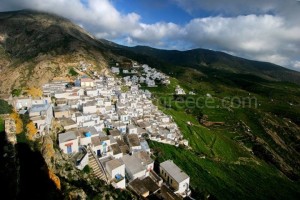
Serifos still maintains its special dance and music traditions. All the travelers that went to Serifos mention the cheerful, happy and merry character of the inhabitants who are living it up. Serifos has customs which aren’t museum souvenirs bia keep on being viable every day. Some of them are briefly mentioned below.
The festivals (panigiria): Almost all the churches celebrate Mass in memory of the Saints they are dedicated to. The institution of “ktitores” (owners), which is valid until today, contributes to the maintenance of the festivals as well as the music and dance tradition of the island. The ktirores, who are also called “brothers”, are a group of people, who responsible for the maintenance of the churchl while offering personal work and money. At the night of the eve, as always, the Vespers and the procession of the icon around the church take place. After that is artoklasia and then” the consecrated bread is distributed to the attendants and thd table is set for the pilgrims. The priest sits at the head of the first table with the chanters. The cooks and the other ktitores sit on the table after all the people are finished eating.
The food offered at the eve is usually fava bean puree with local olives, onion and mixed pickles. At the day of the feast, boiled goat with soup or spaghetti and lots of wine is served. If the day of the feast is a fast-day then the opposite happens. Food and wine during the festivals are offered by the ktitores. After the food starts the entertainment with music and dancing. The festivals used to last many days but today they are reduced to two.
The most important festivals on Serifos are the following:
January 18, Agios Athanasios at Pano Chora
March 25, Evangelistria at Kato Chora
May 5, Agia Irene at Koutalas
May 21, Agios Konstantinos and Agia Eleni at Vagia
Holy Spirit at Megalo Chorio and at Panagia Liomantra
July 1, Agioi Anargiri at Kalavatsena and Galini
July 17, Agia Marina
July 27, Agios Panteleimonas
August 6, Sotiras at Kalo Ampeli and Pyrgos.
Festivals dedicated to Panagia (Virgin Mary) take place at Ramos, Skopiani, Lio-mandra, (August 14), Panagia at Pyrgos (August 15), Panagia at Panagia village (August 16).
August 23, Panagia Mi Hani and Agios Nikolaos at Skala Sikamias
September 7, Agios Sostis
September 8, Panagia at Avessalos.
September 24, Agia Thekla
November 8, Taxiarhes at Monastiri.
November 25, Agia Aikaterini
The wedding: The wedding on the island is a very important event that lasts many days. Some of the customs and manners that take place during the Serifian wedding are the “podokefala”, feast during the preparation and slaughter of the animals for the wedding table, the “(a)manedes”, heavy and slow songs with lyrics referring to the couple, the “mantinades” at the houses of the couple and their parents, the “antigama” which takes place the following Sunday. Of great interest is the setting up of the feast and the dance. The groom leads the dance after he has paid the instrument players and orders the tune he wants them to play for him. According to tradition, apart from the groom and the bride, there is also the best man with his wife and a very close relative of the couple such as the brother of the groom or the bride. The bride’s dance lasts many hours so that all the guests can honor the bride. People keep on saying “three with two” meaning three drinks for the men and two “loukoumia” (Turkish delight) for the women.
After a while, the groom gives his position to the best man who pays the instrument players and orders his own tune. The same is repeated for the third man. Tha bride and the best man’s woman remain to their positions while three other men dance to the position of the first men. Then they dance “mpallos” to complete tha bride’s and every girl’s dance who dances first. After “mpallos” the second gin dances on the front while another girl takes the second position until “mpallosl starts again.
Carnival festivities: At the last Sunday of the carnival the following still take place: “Kapetania”, a mock battle between Pano and Kato Chora or between Chora and the villages. “Gyra” follows which usually starts from Taxiarches Monastery and goes around most of the villages of the island. The “maskaroi”, groups of people who go around the shops that celebrate.
Satirical skits, spontaneous or organized with themes like the Trojan War or the Liberation of Crete etc.
The swing: The swings of Easter were a very old custom that completed the happy atmosphere of Easter mass and offered entertainment to young children and the grown-ups. They put beams, among the houses at the narrow alleys of Chora, where they hang swings. When the girls went to the swings they were swung by the “swing-man” and said short verses like:
“Swing me well swing-man and I will pay you, I will get my slipper off and slap you in the face “.
“Tsouri”: Children’s baptism is an important event. During a baptism, everyone is gathered at the square. When it ends the guests go home and the child’s godfather does the “tsouri”, meaning that he takes money out of his pocket, usually coins, and throws them towards the children who run happily while shouting and try to collect as much as they can.
SERIFOS DANCES
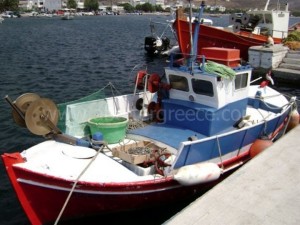
Apokrianos: Simple dancing steps but particularly artistic dialogue. The ex-| change of sarcastic lines among the dancers and others, during the carnival, is| definitely one of the oldest and happiest customs.
Malakos: It has a peculiar step and is separated in two parts. On the first part the dance moves to the left while on the second part it moves to the right. This change happens when the musie changes. The rhythm towards the left is slow, while towards the right it becomes light and fast. Malakos has happy words which, unfor-| tunately, aren’t saved today. Mostly old people used to dance it around the island with slight differences from one region to another.
Sirtos (dragging): The Serifian sirtos “(round) has its own special step and style. The dragging step is interrupted by turns of the couples and figures and each end of the lyrics of the song. It is danced by five (5) people, two couples and a danced at the end who cheers, sings, treats drinks etc. The girls stand still. The first girl will dance with all three dancers. For the second girl to come forward, mpallos has to be played. The style is different in each region.
Mpallos: mpallos in Serifos differs. Its tune isn’t very fast and therefore there is more fooling around between the couple. The first dancer (of sirtos) starts dancing with his partner and then everyone dances with her.
Serifos Sousta: It is slow mpallos with special steps. This dance demands talent and therefore it isn’t seen often.
Kalamatianos: The known rhythm of kalamatianos with a few changes and lyrics about the Serifian llife.
SERIFOS MUSIC
The traditional music in Cyclades presents great interest. There are similarities and differences among the islands. The music in Serifos praises love, nature, Serifos beauties, seasons and working. It has lulls, traditional carols and long-drawn-out love songs. It has sirtos dancing songs and for the table which are usually like kalamatianos tune with lyrics about the Serifian life. At the end of each feast the played “kalinixtia”, a song about goodnight. However, a violinist, Garis, used to change the tune of the song to fast sirtos and so the feast started again.
MUSICAL INSTRUMENTS
In our days, violin and lute are musical instruments that accompany the dances and songs of Serifos. There are also the flute and toumpi which lately are used by a great number of instrument players, after Thodoris Livanios efforts to be recognized as special instruments of our islands. Bagpipes are almost disappeared.
WALKING PATHS ON SERIFOS
Serifos has excellent stone-paved footpaths, easy or difficult to walk to, leading to beaches, historical locations and small churches. You can easily find them by following the relevant signings. It’s never too late for anyone to start knowing the place that offers him hospitality by walking around it. Some of its best footpaths are:
- Chora – Castle – Livadi, Blue signing (50 m)
- Kallitsos (Kentarchos) – Chora, Red signing 1 (lh 30m)
- Chora – Ai Giorgis – Gyftika, Red signing 2 (50 m)
- Akonidia – White Tower – Koutalas, Red signing 3 (lh 10m)
- Gyftika – Varsamo – Panagia, Red signing 4 (lh 40m)
- Panagia – Sikamia, Red signing 5 (lh)
- Pyrgos – Galani – Sikamia, Red signing 6 (lh 10m)
FISHING ON SERIFOS
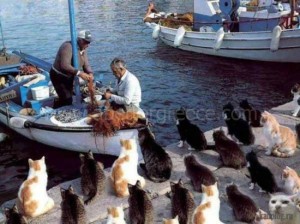
Serifos is a good fishery. It has many places for the fans of fishing as long as there is a boat or a craft. The islets Piperi and Serifopoula are ideal places for longline and deep fishing-line. Avessalos beach and Vous islet are good fisheries for fishing while being on their coasts or on boat. Some nice places for underwater fishing are considered to be Koutalas bay, Spathi cape and the islets Vous, Piperi and Serifopoula. You will find lobsters at many places of the island.,
THE MINES OF SERIFOS
Iron and copper mines existed in Serifos since the antiquity. The mining activities started during the first Cycladic times, 3rd B.C. millennium. The first concession for the mining of magnetic and carbonic iron was granted to the “Greek Mining Company” in 1869 by Otto who used a royal decree. This company went bankrupt and in 1880 the mines were bought by the French Mining Company of Lavrio, which was named “Serifos-Spilialeza”, having as founders rich Greeks from Constantinople with the help of the Ottoman Bank which had British, French and Ottoman interests. It remained active until 1883 but then it was also closed down due to bankruptcy. In 1884 it assigned the contract work of the mines to the German mineralogist Emilios Groman (Emile Grohmann). He founded a small company and merged it with the bankrupted “Serifos-Spiiialeza”, which already had mining foundations on the island. He exploited the mineral wealth of the island and in exchange he gave a wage to its owners and a symbolic amount of money to the Greek state. In a publication of the Greek Ore Miners’ Federation, the veteran miner G. Livanios, based on older people’s testimonies, mentions the following:
“Working conditions for the ore miners, during that time, were barbaric and cruel. They were exposed to the sun while working. At dawn they had to be at the entrance of each gallery and when the sun set they stopped working. They could enjoy the sun only on Sunday because they struggled for a wage that was just enough to live on”.
NOTE: Giorgos Livanios was born in 1920 and was president of the Miners Union from 1958 to 1960.
During Emilios Groman time, 2.800.000 tones were extracted. He died in 1906 and was succeeded by his son Georgios Groman. It is said that a big part of the minerals was exported to Germany having as destination its polemic industry.
The old Serifians claim that “The German metal used in both World Wars was extracted from the bowels of the island”.
During 1914-1916 60 workers lost their lives in the rnine galleries. The Serifians used to work for 16 hours each day, even though there was a law for an 8 hour work. In June 1916, the Union was founded while instigated by K. Speras. On August 7, 1916 the workers denied to load Manousi ship which had as a destination Glasgow or Germany. They demanded an 8-hour job, wage increase and security measures. The magistrate of Serifos, D. Kontos, denied signing a telegram to the Ministry of the Interior, mentioning the workers’ strike and the setting on fire of a warehouse, sent by P. Vassos, the president of the community and the local warrant officer of the gendarmerie.
This telegram was the cause for sending a detachment to the island from Kea, with 10 or 12 gendarmes and the lieutenant of the gendarmerie Chrisanthou in charge, so that the loading of the ship would be ensured. The detachment reached Serifos in the morning of August 21.
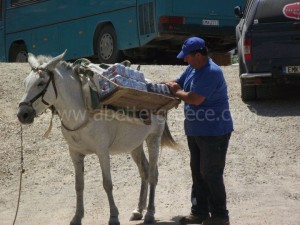
Chrisanthou assaulted whoever stood his way, while he was headed from the port to Meg. Livadi. When he arrived he imprisoned K. Speras and the Union’s leadership. Then he went to the strikers who were on the loading bridge on the right of the beach (the head quarters is on the left) and gave them 5 min notice to load the ship. After these 5 min he shouted “in the name of the king” and shot them in cold blood. Themistoklis Kouzoupis, Mich. Zoilis, Michalis Mitrofanis and Giannis Protopappas were killed. A free-for-all followed, with more than 500 strikers with women and children aniong them.
There were tenths of injured people together with the gendarmes, two of which died.
The lieutenant of the gendarmerie, Chrisanthou, and the policeman of Serifos Giannis Triantafillou were stoned to death. Triantafillou was pushed of the loading bridge and fell into the sea. According to the local version, it was a woman who crushed the lieutenant’s head. K. Speras, who had just gotten out of jail, tried to hold the crowd, just like the priest Giannis Rotas did. The fight stopped when K. Speras took a French flag and shouted: “In the name of the French Democracy, put your weapons down”.
The administration and some of the workers were imprisoned in Syros. The wages were increased and the 8-hour work was settled for the underground jobs in 1925. The mines vegetated until 1934.
In 1933, Emilios, Georgios’ son, took over the administration of the mines. In 1943 he became officer of the Germans and after the end of the war he was sentenced as a war criminal and disappeared. After the Groman’s departure, the exploitation started again in 1954 by the company “Mediterranean Club of Trade and Industry” represented by Apostolidis who was the vice-president of Karamanlis government. However, in 1963, it suddenly went bankrupt and all those who were in charge disappeared without paying the miners. Since then the mines were shut down. In July 20 1963, at least 300 miners, who were owed the wages of 6-7 months, marched from Meg. Livadi towards Chora (3 hours way), where the company’s offices were situated, in order to find its manager. However, he had already left with the last boat that loaded the last shipment from the island. Today, everything is in ruins at Meg. Livadi: buildings, wagons, half-collapsed loading bridges and galleries’ entrances. Even the Groman’s head quarters, a neoclassical building, is about to completely collapse. The owners, Aggelopoulos family, recently donated it to Serifos Municipality but it might be collapsed until it is repaired.
USEFUL TELEPHONE NUMBERS ON SERIFOS
| Main police station on Serifos | +30 22810 51300 |
| Port Police on Serifos | +30 22810 51470 |
| Hospital / Health center on Serifos | +30 22810 51202 |
| Fire department on Serifos | +30 199 |
| Tourist information office on Serifos | +30 22810 51300 |
| Ambulance on Serifos | +30 22810 51202 |
| Tourist police on Serifos | +30 22810 51300 |
| Ferry schedules on Serifos | +30 22810 51488 |
| Travel agency on Serifos | +30 22810 52362 |
| Travel agency on Serifos | +30 22810 51488 |
| Taxi station on Serifos | +30 22810 |
| Post office on Serifos | +30 22810 51239 |
| Pharmacy on Serifos | +30 22810 51205 |
